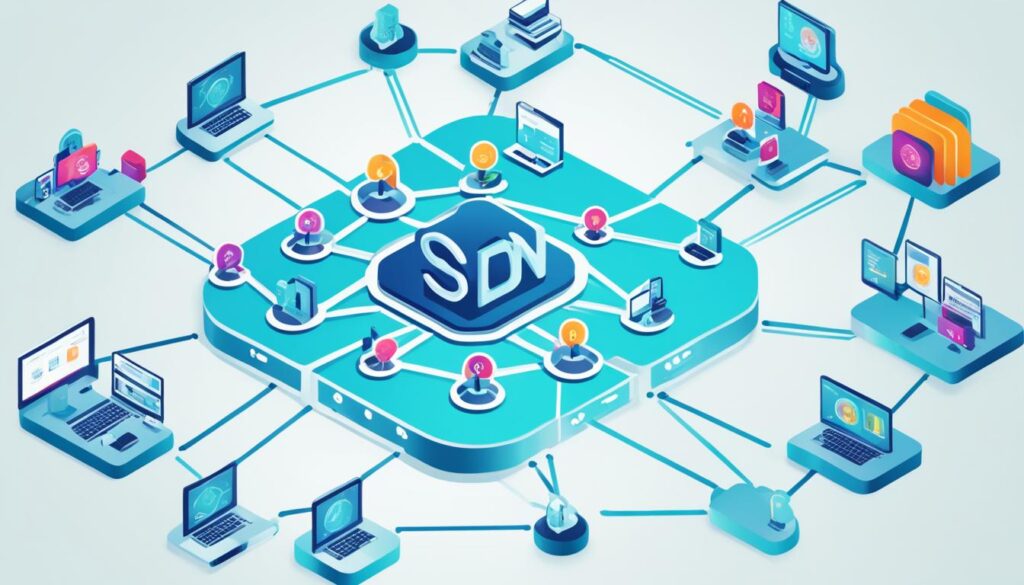Welcome to our comprehensive guide on network segmentation and its critical role in improving cybersecurity. In today’s digital landscape, organizations face increasing threats from cybercriminals seeking to exploit network vulnerabilities. However, by implementing network segmentation, organizations can effectively enhance their network security and mitigate the risks associated with data breaches. Let’s explore the importance of network segmentation, cybersecurity best practices, and how it can help protect your network infrastructure.
Key Takeaways:
- Network segmentation is crucial for improved cybersecurity and data breach prevention.
- Implementing network segmentation best practices enhances network security and reduces the impact of potential breaches.
- Network segmentation involves dividing a computer network into multiple subnetworks to improve performance and security.
- By creating separate segments, network segmentation prevents a single point of failure and limits unauthorized access across the entire network.
- Following the principle of least privilege, limiting third-party access, and regularly monitoring the network are essential aspects of effective network segmentation.
What is Network Segmentation?
Network segmentation, also known as network partitioning or network isolation, involves dividing a computer network into multiple subnetworks to improve performance and enhance security. In a flat network, where all systems connect without intermediary devices, unauthorized users can easily gain access to the entire system through one access point. However, with network segmentation, malicious traffic is contained within the breached section, allowing IT teams to locate the breach and minimize the impact of the intrusion. This practice effectively prevents lateral network attacks and enhances overall network security.

Why is Network Segmentation Important?
Network segmentation plays a crucial role in improving the performance and security of computer networks. By dividing a network into smaller subnetworks, network segmentation helps in:
- Improved Performance: Network segmentation reduces congestion and improves the speed and efficiency of data transmission within the network.
- Enhanced Security: With network segmentation, potential breaches and malicious traffic are contained within specific segments, reducing the impact of cybersecurity incidents and making it easier to isolate and address vulnerabilities.
- Better Control: Network segmentation allows organizations to apply specific security policies and access controls to different segments, ensuring that sensitive data and critical systems are adequately protected.
Implementing network segmentation best practices is crucial to maximize the benefits it offers. The next section will explore some of these best practices in detail.
Benefits of Network Segmentation
Implementing network segmentation offers several benefits for organizations. Firstly, it
strengthens security
by creating a multi-layered attack surface, preventing lateral network attacks, and containing attackers within the breached segment. Secondly, network segmentation
improves network monitoring
by isolating incidents and enabling quick threat identification. Additionally, it
enhances operational performance
by limiting traffic to specific zones, reducing congestion, and boosting overall network performance. Moreover, network segmentation
reduces the scope of compliance
by separating regulated data from other systems, enabling targeted policy application.
| Benefits of Network Segmentation | |||
|---|---|---|---|
| Strengthened Security | Improved Network Monitoring | Enhanced Operational Performance | Reduced Scope of Compliance |
| Prevents lateral network attacks and contains attackers within breached segment | Isolates incidents and enables quick threat identification | Limits traffic to specific zones, reducing congestion and boosting network performance | Separates regulated data from other systems, enabling targeted policy application |
Network segmentation has become a critical component of modern cybersecurity strategies. By implementing robust network segmentation practices, organizations can enjoy strengthened security measures that prevent unauthorized access. The multi-layered attack surface created by network segmentation acts as a barrier, making it challenging for attackers to compromise the entire network. In the event of a breach, the segmentation approach ensures that attackers are contained within a specific segment, minimizing the impact on the rest of the network.
Improved network monitoring is another significant benefit of network segmentation. By isolating incidents within specific segments, IT teams can quickly identify and address threats, preventing them from spreading to other parts of the network. This proactive approach enables organizations to respond swiftly and effectively, reducing the potential damage and downtime caused by cyberattacks.
Furthermore, network segmentation enhances operational performance by limiting traffic to specific zones. By segmenting the network and directing traffic accordingly, congestion can be minimized, resulting in improved overall network performance. This optimization ensures that critical applications and services receive the necessary bandwidth and resources, mitigating the risk of network bottlenecks.
In addition to bolstering security and improving network performance, network segmentation also has compliance benefits. By separating regulated data from other systems, organizations can more effectively apply targeted policy and compliance measures. This separation reduces the scope of compliance requirements and simplifies the process of meeting regulatory obligations.
Overall, the benefits of network segmentation are clear: strengthened security, improved network monitoring, enhanced operational performance, and reduced scope of compliance. By implementing network segmentation strategies and practices, organizations can safeguard their networks, optimize performance, and meet regulatory requirements effectively.

Network Segment Examples
When it comes to implementing network segmentation, there are several methods that organizations can choose from. These methods include VLAN segmentation, firewall segmentation, and SDN segmentation. Each method offers unique advantages and challenges, allowing organizations to select the most suitable approach based on their network architecture and requirements.
VLAN Segmentation
VLAN segmentation involves creating smaller network segments that connect hosts virtually. By dividing the network into VLANs, organizations can improve network performance and enhance security. VLANs can be implemented at the physical or logical level, allowing for more granular control over network traffic and access.
Firewall Segmentation
Firewall segmentation utilizes firewalls to enforce network segmentation by creating internal zones that partition functional areas. This method helps organizations isolate and protect critical assets by restricting traffic flow between different network segments. By implementing firewall segmentation, organizations can enhance security and minimize the impact of potential breaches.
SDN Segmentation
SDN segmentation is a more modern approach that applies automated network overlays to achieve network segmentation. Software-Defined Networking (SDN) allows organizations to create virtual networks that are separate from the underlying physical infrastructure. This method offers flexibility and scalability, making it easier to configure and manage network segments.
Each network segmentation method has its own benefits and challenges. Organizations should carefully evaluate their network infrastructure and requirements to determine the most appropriate method to implement network segmentation. By effectively implementing network segmentation, organizations can enhance their network security, improve performance, and mitigate the risk of unauthorized access.

7 Network Segmentation & Segregation Best Practices
To optimize network segmentation, organizations should follow several best practices. These include:
- Following the principle of least privilege: This practice ensures that users and devices have access only to the resources they need to perform their tasks. By limiting access based on actual need, organizations can minimize the potential for unauthorized access.
- Limiting third-party access: Granting access to third-party vendors or partners should be done carefully and with strict controls in place. By minimizing third-party access, organizations can reduce the potential vulnerabilities introduced by external parties.
- Auditing and monitoring the network: Regularly monitoring and auditing the network helps identify and isolate any incidents or breaches. This allows organizations to take immediate action and mitigate any potential risks.
- Making legitimate paths easier than illegitimate paths: By prioritizing security, organizations can ensure that legitimate paths to access network resources are easier to navigate than unauthorized paths. This discourages unauthorized access attempts and encourages adherence to security protocols.
- Combining similar network resources: Streamlining security operations by combining similar network resources can simplify management and ensure consistent security settings and policies.
- Avoiding over-segmentation: While network segmentation is essential, over-segmentation can lead to complexity and inefficiency. It is important to strike a balance between segmenting the network appropriately and avoiding excessive fragmentation.
- Visualizing the network: Creating a visual representation of the network can help organizations understand its structure and access requirements more effectively. Visualization can aid in identifying potential weak points and optimizing segmentation efforts.
By implementing these network segmentation and segregation best practices, organizations can enhance their cybersecurity posture and strengthen the overall security of their networks.
How to Securely Implement Network Segmentation
Implementing network segmentation can be a complex and costly process if not done properly. To securely implement network segmentation, organizations should follow a comprehensive strategy that incorporates various factors such as expense, complexity, communication, security policies, asset values, and automation.
First and foremost, organizations must establish detailed security policies that outline the objectives, guidelines, and procedures for network segmentation. These policies should address the specific needs and requirements of the organization, considering factors such as the sensitivity of data, regulatory compliance, and business operations.
Next, organizations should identify and classify their assets based on their value and sensitivity. By understanding the importance of each asset, organizations can prioritize their efforts and allocate appropriate resources to secure key components of the network.
Allowlists, also known as whitelists, should be implemented to control access to different network segments. By explicitly specifying the entities or devices allowed to communicate with each segment, organizations can enforce strict network boundaries and mitigate potential security risks.
Technologies such as firewalls, access control lists, and virtual LANs (VLANs) can be deployed to enforce network segmentation. Firewalls act as barriers between network segments, preventing unauthorized access and filtering traffic based on predetermined rules. Access control lists define the access permissions for different devices or users, allowing organizations to enforce network segmentation policies. Virtual LANs provide a logical separation of network devices into different segments, enhancing security and isolation.
Depending on the specific requirements and infrastructure of the organization, both physical and logical separation methods can be used for network segmentation. Physical separation involves physically separating critical network components and restricting physical access, while logical separation involves the use of virtual measures to create secure segments within the network infrastructure.
Automation plays a crucial role in the implementation and maintenance of network segmentation. By automating repetitive tasks and processes, organizations can ensure consistent application of security practices, reduce human error, and improve efficiency. Automation tools and technologies can assist in configuration management, policy enforcement, and network monitoring.
Overall, a well-planned and securely implemented network segmentation strategy can enhance the organization’s security posture, protect valuable assets, and reduce the potential impact of security incidents. By considering factors such as expense, complexity, communication, security policies, asset values, and automation, organizations can establish a robust network segmentation framework that aligns with their specific needs and effectively mitigates security risks.

Conclusion
Network segmentation is a critical component of a robust cybersecurity strategy, providing organizations with improved security and data breach prevention. By implementing network segmentation best practices, such as following the principle of least privilege and limiting third-party access, organizations can strengthen their defense against cyber threats.
Network segmentation also enhances network monitoring capabilities, allowing quick threat identification and containment. By creating separate network segments, organizations can isolate incidents and minimize the scope of attacks, preventing unauthorized access to sensitive data and systems.
In addition to bolstering security, network segmentation improves overall operational performance by reducing traffic congestion and optimizing network resources. It also facilitates compliance with regulations by allowing organizations to separate and control access to regulated data.
To effectively secure their networks, organizations should develop clear security policies, allocate resources, and consider leveraging automation technologies. By prioritizing network segmentation and implementing it in a methodical and comprehensive manner, organizations can achieve improved security and network protection.
FAQ
What is network segmentation?
Network segmentation involves dividing a computer network into multiple subnetworks to improve performance and security. It creates separate segments to prevent a single point of failure and make it difficult for unauthorized users to compromise the entire network.
What are the benefits of network segmentation?
Network segmentation strengthens security by creating a multi-layered attack surface, improves network monitoring by isolating incidents, enhances operational performance by limiting traffic, and reduces the scope of compliance by separating regulated data from other systems.
What are some examples of network segmentation methods?
Network segmentation methods include VLAN segmentation, firewall segmentation, and SDN segmentation. VLANs create smaller network segments virtually, subnets use IP addresses for segmentation, firewalls enforce segmentation by creating internal zones, and SDN segmentation applies automated network overlays.
What are the best practices for network segmentation and segregation?
Best practices for network segmentation include following the principle of least privilege, limiting third-party access, auditing and monitoring the network, prioritizing security by making legitimate paths easier than illegitimate ones, combining similar network resources to streamline operations, avoiding over-segmentation, and visualizing the network’s structure and access requirements.
How can network segmentation be securely implemented?
To securely implement network segmentation, organizations should create detailed security policies, identify and classify their assets based on value and sensitivity, use allowlists to control access, leverage technologies such as firewalls and access control lists, and consider physical and logical separation methods. Automation can help streamline implementation and maintenance.








